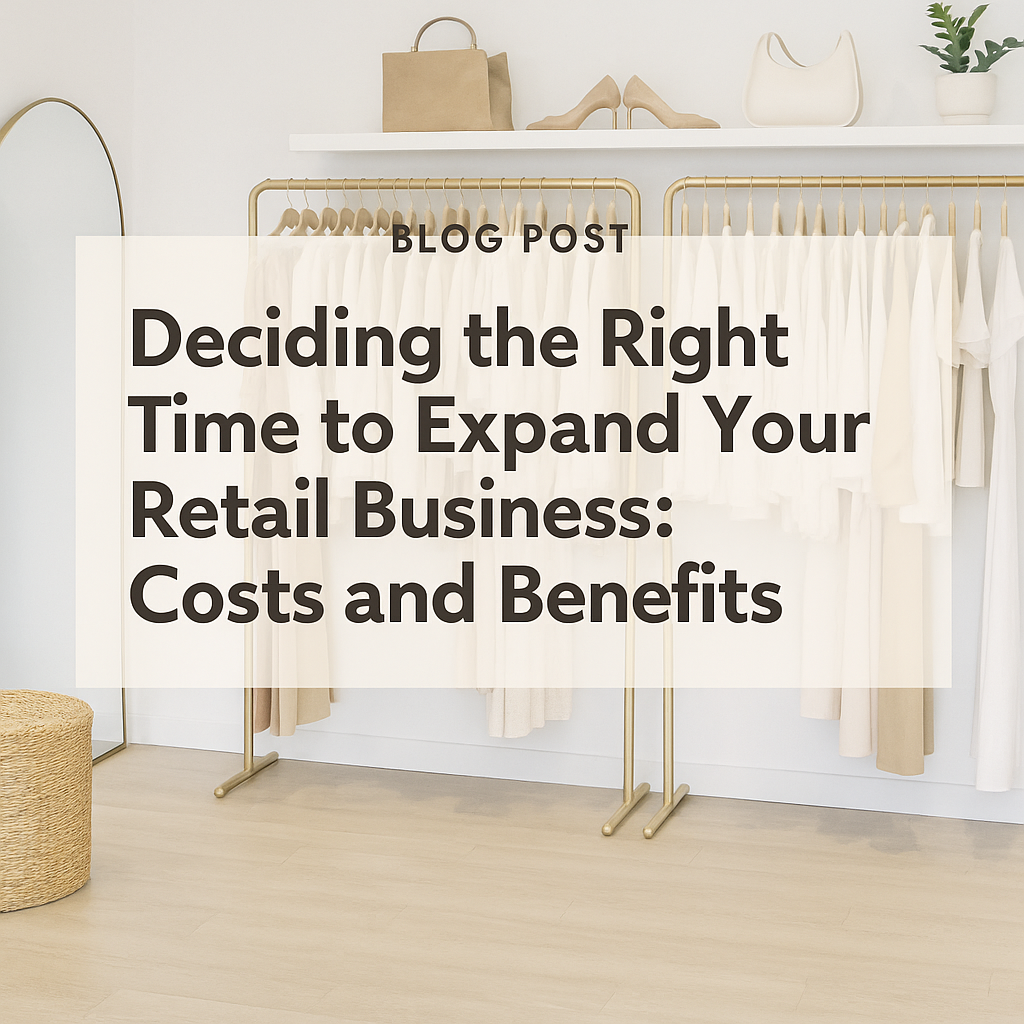Deciding the Right Time to Expand Your Retail Business: Costs and Benefits

For retail business owners, the decision to expand by opening additional locations is an exciting but complex choice.
Expansion can signal success and unlock new opportunities, but it also comes with challenges that require careful planning. The question is, how do you know when the right time has arrived? And how can opening new locations take your business to new heights, but also, at what cost?
Here’s a guide to help you evaluate your business’s readiness for expansion and better understand the cost and benefits of growing your retail footprint.
Key Factors to Consider Before Expanding Your Retail Business
1. Market Demand
Start by assessing whether there’s sufficient demand in a new market to justify opening another location. Conduct market research to identify potential areas with demographics that align with your target audience. Look for key indicators like customer spending habits, local competition, and foot traffic data. Do these areas have room for your business to thrive? If demand in your current location has proven strong and you’re seeing consistent overspill or inquiries from new markets, it could be the right time to expand.
2. Financial Stability
Expansion requires a significant financial commitment. Evaluate the health of your existing location(s). Are sales consistent? Beyond that, do you have the capital to cover the costs of opening a new location, including real estate, hiring, marketing, and the inevitable ups and downs of the first year?
Financial stability also means ensuring your current store can operate with less of your own time and attention while you focus on launching the next. However, do not get caught in the trap of expecting your first store to be profitable enough to fund additional locations. Often, first stores run on very slim margins because they have little access to economies of scale, and consequently bear a higher cost burden than subsequent stores. For example, a second store of equal or lesser volume will only require an additional 1.5 headcount, not double the headcount of the first store, because the two locations can share staff.
Generally, expect that at least a portion of the start-up costs for stores 2-4, will require additional capital beyond cash flow generated by your existing stores. Build a financial cushion to mitigate risks, AND ensure your cash flow can handle the added pressure.
3. Operational and Team Capacity
Successfully running a multi-location retail business isn’t just about replicating your store. Your business operations must be scalable. Evaluate your processes for inventory management, staffing, training, and customer service. Can they be expanded without dilution? A franchise system will have already considered and tested these systems in multiple locations, but even as a franchisee you need to do a gut check and ensure that you’re following the systems in a way that allows for growth.
Your team will play a critical role in this. Assess leadership bandwidth and whether you have the right people to oversee operations across multiple locations or if you’ll need to recruit and develop talent.
4. Brand Scalability
Consistency is key in retail. Customers expect the same experience, quality, and level of service across all your locations. Before expanding, ensure you’ve built a scalable brand identity and that new locations can be aligned with the reputation of existing ones. This includes creating clear guidelines for store design, product offerings, and customer service standards. If you’re part of a franchise system, this work has already been done and you can check it off the list. If not, it’s important to pause here and take the time and investment to establish your brand identity in order to benefit from greater brand recognition when you grow.
5. Community Engagement and Demand Signals
If you’ve heard repeat customer requests for your presence in a new area or seen strong interest on your digital channels from potential new regions, take that as a green light. Community engagement is a powerful sign that your brand resonates beyond your current market. Leveraging the loyalty and enthusiasm of your existing customer base to build momentum in a new area can make a big difference.
The Benefits of Expanding Your Retail Locations
When done right, opening additional locations offers both short- and long-term advantages. Here’s how expansion can impact your business positively:
1. Expanded Revenue Opportunities
With more locations, you’ll have access to a larger customer base, which often translates to increased sales and revenue. If your first location is already maxing out its potential, opening a second location allows you to grow without overburdening an existing store.
2. Greater Brand Recognition
Each additional location strengthens your brand presence and increases visibility. A larger footprint can make your brand synonymous with trust, accessibility, and relevance in the industry, giving you an edge over competitors who may not yet be in those markets.
3. Market Diversification and Risk Mitigation
Operating in multiple locations expands your revenue streams and reduces risk. For instance, if one market faces economic challenges or seasonal downturns, performance in another market can help balance your business operations. Even stores within close geographic proximity can experience significantly different traffic patterns, allowing the business as a whole to better endure external threats. For example, if you have a store in a shopping center that undergoes a large renovation, it can restrict access and visibility to your storefront for extended periods and put a strain on the store’s ability to perform for weeks or months. Having another storefront, even if it’s 10 minutes away, would allow you to continue to generate sales and support the first store through that downturn.
4. Economies of Scale
Businesses with multiple locations often enjoy benefits from economies of scale, especially when it comes to procurement and logistics. Increasing your order volume across additional storefronts may allow you to reduce costs on supplies, labor and marketing spend. Depending on the type of retail store you have, it can also reduce inventory costs or allow for the opportunity to negotiate more favorable terms with vendors. In a consignment model like The Closet Trading Company, you can rotate the consigned inventory across multiple stores, increasing the likelihood of sell-through for your consignors and lowering your new consignor acquisition costs by leveraging the value of the clients you have already earned.
5. Employee Development
Expansion creates opportunities for staff advancement and new roles. When your workforce sees growth opportunities within the company, it increases morale and fosters loyalty. Promoting trusted team members to leadership roles at new locations ensures your company culture is upheld.
6. Enhanced Customer Loyalty
Customers love convenience. By expanding to new regions, you’re making it easier for them to engage with your brand. Being physically present in more communities helps cement strong customer relationships and may even attract loyal patrons from one location to another.
When It’s Time, Expand Carefully
The potential rewards of opening additional locations are significant, but the key lies in timing and preparation. Rushing into new territories without the proper foundation can jeopardize not just your expansion but also your existing operations. Take the time to conduct thorough research, assess your financial and operational readiness, and have a solid plan in place to ensure consistency in execution.
